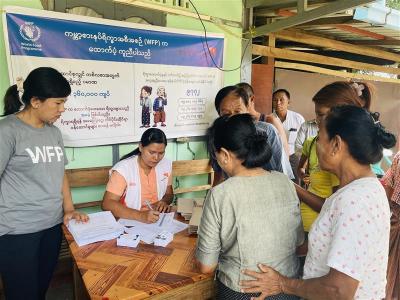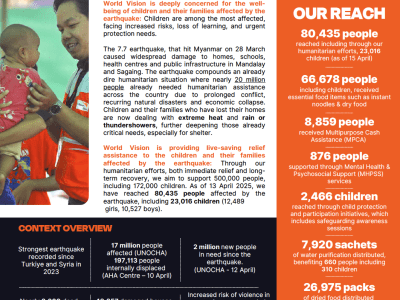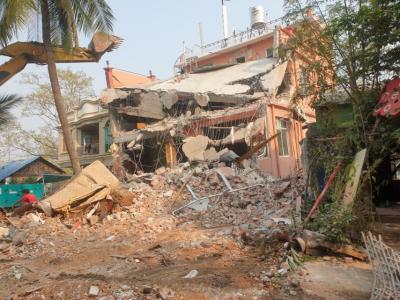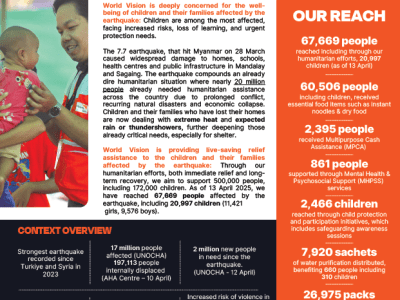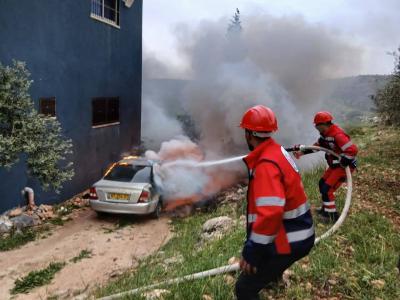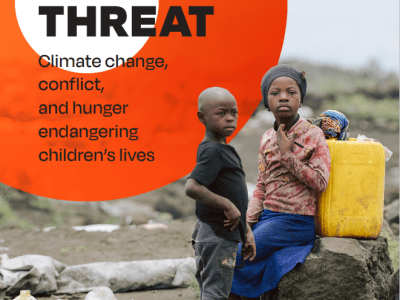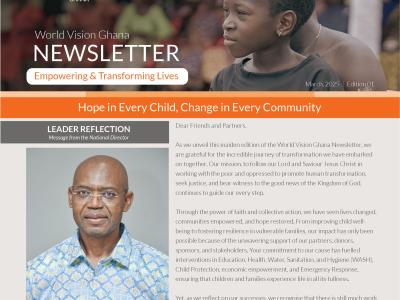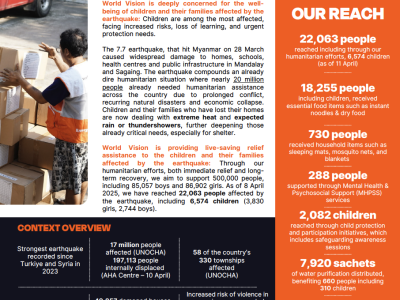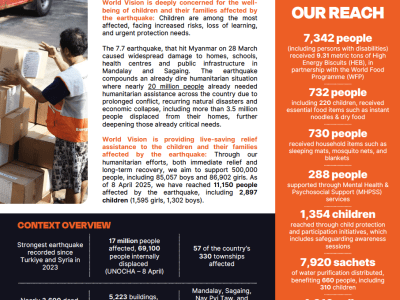article / April 16, 2025
World Vision in partnership with World Food Programme bring hope and support to Myanmar earthquake survivors
As part of WV’s Myanmar Earthquake Response, in partnership with WFP, 8,859 people have received Multipurpose Cash Assistance (MPCA). The World Food Programme and World Vision have been in long-term partnership for years prior to the earthquake. With WFP's support, World Vision has provided support to vulnerable families and children through various initiatives, including food distribution, maternal and child cash transfers, assistance for internally displaced persons (IDPs), and cash-for-assets programmes.
publication / April 16, 2025
Myanmar Earthquake | Situation Update | Edition 4
World Vision is deeply concerned for the well-being of children and their families affected by the earthquake: Children are among the most affected, facing increased risks, loss of learning, and urgent protection needs. World Vision is providing life-saving relief assistance to the children and the families affected by the earthquake. We aim to support 500,000 people, including 85,057 boys and 86,902 girls, through both immediate relief and long-term recovery efforts.
press release / April 2, 2025
Myanmar Children at Risk of Abuse and Exploitation Following Devastating Earthquake, Warns World Vision
World Vision warns of increased child abuse risk in Myanmar post-earthquake. Displacement and separation from families heighten vulnerability. Urgent aid needed.
publication / April 14, 2025
Myanmar Earthquake | Situation Update | Edition 3
World Vision is deeply concerned for the well-being of children and their families affected by the earthquake: Children are among the most affected, facing increased risks, loss of learning, and urgent protection needs. World Vision is providing life-saving relief assistance to the children and the families affected by the earthquake. We aim to support 500,000 people, including 85,057 boys and 86,902 girls, through both immediate relief and long-term recovery efforts.
publication / April 16, 2025
World Vision - SitRep - Emergency Response West Bank - Feb-Mar25
Due to unprecedented levels of violence, restrictions on movement and economic challenges, a major humanitarian crisis is ongoing in the West Bank. To support communities, World Vision has continued its emergency response in february and March 2025, reaching 193,000 people including 110,000 children in 7 governorates. Read our report to learn more about our response.
publication / April 17, 2025
Triple Threat: Climate Change, Conflict and Hunger endangering children's lives
Climate change, violence, and hunger are trapping vulnerable children in poverty. This report explores their intersection and the urgent need for action.
publication / April 9, 2025
World Vision Ghana Newsletter - Edition April 2025
Thank you for your support and partnership. Explore our newsletter to learn more about our initiatives and how you can get involved.
publication / April 11, 2025
Myanmar Earthquake | Situation Update | Edition 2
World Vision is deeply concerned for the well-being of children and their families affected by the earthquake: Children are among the most affected, facing increased risks, loss of learning, and urgent protection needs.
press release / March 28, 2025
World Vision responds to central Myanmar earthquake
Press release about the earthquake that shook Myanmar on March 28, 2025
publication / April 10, 2025
Myanmar Earthquake | Situation Update | Edition 1
World Vision is concerned for the well-being of children and their families affected by the earthquake: Children are among the most affected, facing increased risks, loss of learning, and urgent protection needs.
The 7.7 earthquake, that hit Myanmar on 28 March causing widespread damage to schools, health centres, and public infrastructure in Mandalay and Sagaing, compounds an already dire humanitarian situation in Myanmar
